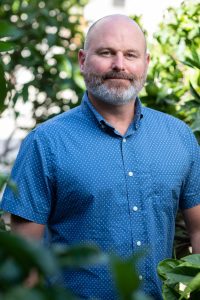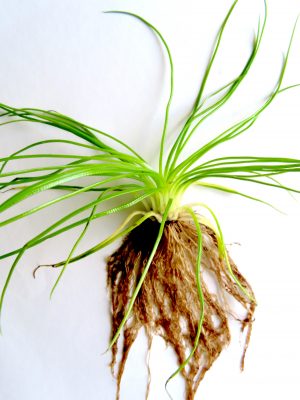
November 3, 2021
Researchers explore how aquatic plants regulate photosynthesis to compete for carbon dioxide underwater
Researchers explore how aquatic plants regulate photosynthesis to compete for carbon dioxide underwater
LA JOLLA—The humble quillworts are an ancient group of about 250 small, aquatic plants that have largely been ignored by modern botanists. Now, Salk scientists, along with researchers from the Boyce Thompson Institute, have sequenced the first quillwort genome and uncovered some secrets of the plant’s unique method of photosynthesis—secrets that could eventually lead to the engineering of crops with more efficient water use and carbon capture to address climate change. The findings were published in Nature Communications on November 3, 2021.

“Plants are truly amazing at developing novel strategies to extract resources like carbon from their environment,” says co-corresponding author Todd Michael, research professor in the Plant Molecular and Cellular Biology Laboratory. “By exploiting this ingenuity across an array of unique plants like Isoetes we are developing a toolbox to engineer plants of the future to draw down more carbon.”
Most plants breathe in carbon dioxide (CO2) during the day and use sunlight to turn the gas into sugars. But plants in arid regions have evolved to breathe in CO2 at night instead. This strategy—called CAM photosynthesis—helps the plants avoid water loss during the day.
Forty years ago, quillworts—plants of the genus Isoetes—became the first group of aquatic plants discovered to use CAM photosynthesis. Daytime water loss is clearly not a problem for the aquatic plants. Instead, quillworts use CAM to collect CO2 dissolved in water and store it overnight, to avoid competing with other aquatic plants and organisms, such as algae, that deplete water levels of the gas during the daytime.
“As aquatic plants, Isoetes have evolved CAM photosynthesis in a fundamentally different environment than terrestrial plants in dry habitats,” says co-corresponding author Fay-Wei Li, assistant professor at the Boyce Thompson Institute and adjunct assistant professor at Cornell University.
To investigate the genetic mechanisms regulating quillworts’ CAM photosynthesis process, the team assembled a genome for the quillwort species Isoetes taiwanensis. The team used the genome to identify CAM pathway genes and to examine their patterns of activity (what scientists call gene expression), including how those patterns changed across the day/night cycle. One notable difference between CAM in quillworts and terrestrial plants is in the function of the enzyme phosphoenolpyruvate carboxylase (PEPC). All plants have two types of PEPC: plant-type, long known for its essential role in photosynthesis; and bacterial-type, which resembles the PEPC found in bacteria.

“In all other plants, bacterial-type PEPC plays a role in a range of metabolic processes but not photosynthesis,” said David Wickell, a graduate student in Li’s laboratory and first author on the study. “In Isoetes, both types appear to be involved in CAM—something that hasn’t been found in any other plant and points to a distinct role for bacterial-type PEPC in aquatic CAM.”
Plants have an internal timing mechanism called a circadian clock that ensures biological processes occur at the correct time. In previous work, the Michael lab showed that almost all gene expression is controlled by the circadian clock and that this mechanism was shared across all plants tested. Isoetes are the first plants to date that have a unique circadian system with expression levels of a few timing regulators peaking at different times of the day. The findings provide critical insight into novel mechanisms plants utilize to capture carbon.
The results could be used to engineer crops to better withstand environmental stresses. Wickell says the idea is exciting, but the key would be manipulating the circadian clock genes that regulate CAM components to help plants become more efficient at conserving water or making better use of the available CO2.
Other authors include Nolan T. Hartwick of Salk; Li-Yaung Kuo of National Tsing Hua University in Taiwan; Hsiao-Pei Yang of the Boyce Thompson Institute; Amra Dhabalia Ashok, Iker Irisarri, Armin Dadras, Sophie de Vries and Jan de Vries of the University of Goettingen in Germany; Yao-Moan Huang of the Taiwan Forestry Research Institute; Zheng Li of the University of Texas at Austin; and Michael S. Barker of the University of Arizona.
The work was funded by the Boyce Thompson Institute, the European Research Council (ERC) and the International Max Planck Research School (IMPRS) for Genome Science.
Posted courtesy of the Boyce Thompson Institute.
About Boyce Thompson Institute:
Opened in 1924, Boyce Thompson Institute is a premier life sciences research institution located in Ithaca, New York. BTI scientists conduct investigations into fundamental plant and life sciences research with the goals of increasing food security, improving environmental sustainability in agriculture, and making basic discoveries that will enhance human health. Throughout this work, BTI is committed to inspiring and educating students and to providing advanced training for the next generation of scientists. BTI is an independent nonprofit research institute that is also affiliated with Cornell University. For more information, please visit BTIscience.org.
DOI: 10.1038/s41467-021-26644-7
JOURNAL
Nature Communications
AUTHORS
David Wickell, Li-Yaung Kuo, Hsiao-Pei Yang, Amra Dhabalia Ashok, Iker Irisarri, Armin Dadras, Sophie de Vries, Jan de Vries, Yao-Moan Huang, Zheng Li, Michael S. Barker, Nolan T. Hartwick, Todd P. Michael and Fay-Wei Li
Office of Communications
Tel: (858) 453-4100
press@salk.edu
Unlocking the secrets of life itself is the driving force behind the Salk Institute. Our team of world-class, award-winning scientists pushes the boundaries of knowledge in areas such as neuroscience, cancer research, aging, immunobiology, plant biology, computational biology and more. Founded by Jonas Salk, developer of the first safe and effective polio vaccine, the Institute is an independent, nonprofit research organization and architectural landmark: small by choice, intimate by nature, and fearless in the face of any challenge.